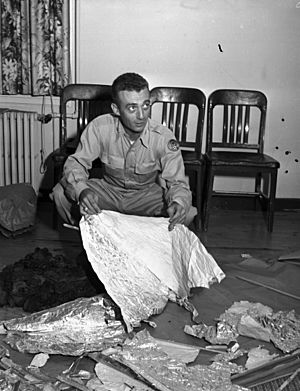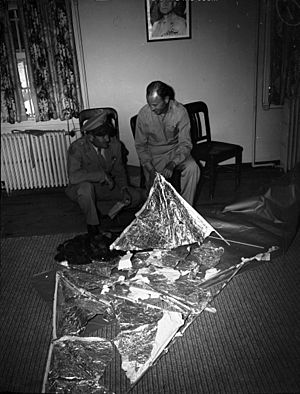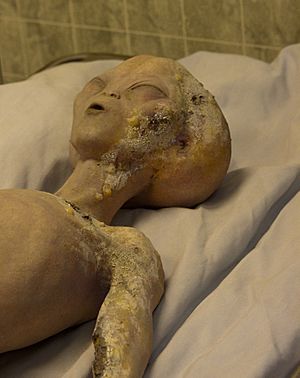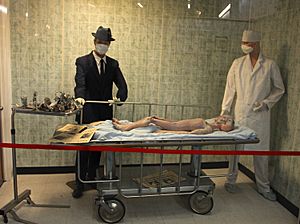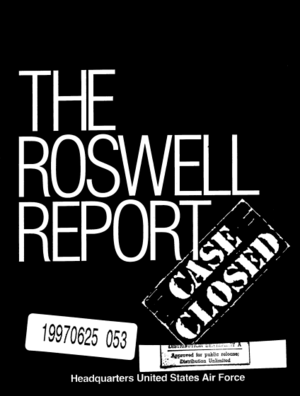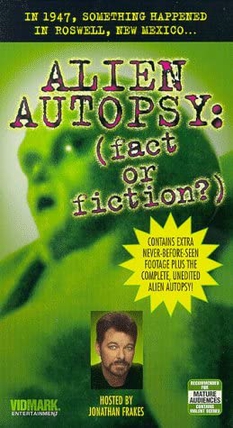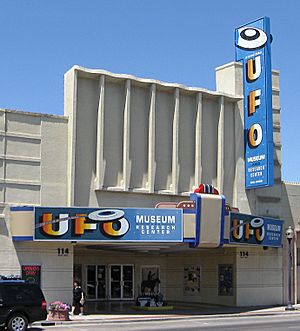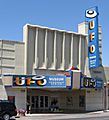Roswell incident facts for kids
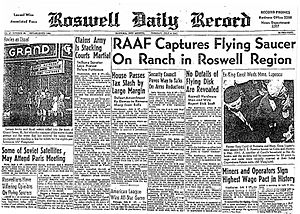
July 8, 1947, issue of the Roswell Daily Record, announcing the "capture" of a "flying saucer"
|
|
| Date | 1947 |
|---|---|
| Location | Lincoln County, New Mexico, US |
The Roswell incident is a famous event from 1947. It involves the discovery of strange debris on a ranch near Corona, New Mexico. Officers from Roswell Army Air Field found the material.
At first, the Army said they had found a "flying disc." This caused a lot of excitement! But soon after, they changed their story. They said the object was just a normal weather balloon.
Years later, in the late 1970s, a retired officer named Jesse Marcel spoke out. He said he believed the debris was from an alien spacecraft. This led to many conspiracy theories. People claimed the government had found a flying saucer and alien bodies, then covered it up.
In 1994, the United States Air Force released a report. It said the crashed object was a special balloon from Project Mogul. This project secretly watched for nuclear tests. A second report in 1997 added that stories of "alien bodies" likely came from test dummies dropped from planes.
Despite these reports, the conspiracy theories continue. The Roswell incident remains very popular in movies and books. It's often called "the world's most famous... UFO claim." The city of Roswell, New Mexico has even embraced the story. Its official seal now has a little green man!
Contents
- Events of July 1947: What Happened?
- Conspiracy Theories: The Alien Story Begins
- Renewed Interest: Jesse Marcel's New Story (1978)
- The Roswell Incident Book (1980)
- UFO Crash at Roswell Book (1991)
- Air Force Response: Project Mogul (1994–1997)
- Alien Autopsy Footage (1995)
- The Day After Roswell Book (1997)
- Haut Document (2007)
- Stalin-Mengele Theory (2011)
- Continued Debunking (2017–2020)
- Evidence: What Do We Know?
- Presidential Comments on Roswell
- Roswell as a Modern Myth
- In Popular Fiction
- Images for kids
- See also
Events of July 1947: What Happened?
The Roswell incident happened during a time when many people were reporting "flying saucers." On June 26, 1947, pilot Kenneth Arnold saw strange objects. His story made headlines and led to hundreds of similar sightings.
On July 5, 1947, a rancher named W.W. "Mac" Brazel went to town. His ranch had no phone or radio. So, he didn't know about the "flying saucer" news.
Brazel had found some strange debris three weeks earlier. It was tinfoil, rubber, and thin wooden sticks. The pieces were spread over a large area. He had just pushed them under some bushes.
After hearing about flying discs in town, Brazel decided to check his debris again. On July 6, he dug it out. The next day, July 7, he took it to the sheriff's office in Roswell. The sheriff called the Roswell Army Air Field.
Major Jesse Marcel was sent to investigate. Brazel took Marcel back to the ranch. They gathered more pieces of rubber and tinfoil. Marcel took the material home that night.
On July 8, Marcel showed the material to his commander, Colonel William Blanchard. Blanchard reported it to General Roger Ramey. Ramey ordered the material flown to Fort Worth Army Air Field (FWAAF) right away. Marcel flew with the material to FWAAF.
That same day, July 8, a public information officer named Walter Haut released a statement. It said the Army had found a "flying disc" on a ranch near Roswell.
The statement read:
The many rumors regarding the flying disc became a reality yesterday when the intelligence office of the 509th Bomb group of the Eighth Air Force, Roswell Army Air Field, was fortunate enough to gain possession of a disc through the cooperation of one of the local ranchers and the sheriff's office of Chaves County.
The flying object landed on a ranch near Roswell sometime last week. Not having phone facilities, the rancher stored the disc until such time as he was able to contact the sheriff's office, who in turn notified Maj. Jesse A. Marcel of the 509th Bomb Group Intelligence Office.
Action was immediately taken and the disc was picked up at the rancher's home. It was inspected at the Roswell Army Air Field and subsequently loaned by Major Marcel to higher headquarters.
A radio announcer, Frank Joyce, later remembered calling Haut. He warned Haut not to run the story, saying he would "be in trouble."
When Marcel brought the material to General Ramey's office, Ramey and his chief of staff, Colonel Thomas Dubose, looked at it. They quickly said it was just parts of a weather balloon. A weather officer explained that these balloons were used across the country. They had a reflective device that looked like a silver star. The balloons would burst high in the sky, and pieces would fall to the ground.
The Roswell Daily Record newspaper described the debris on July 9, 1947:
The balloon which held it up, if that was how it worked, must have been 12 feet [3.5 m] long... The rubber was smoky gray in color and scattered over an area about 200 yards [180 m] in diameter. When the debris was gathered up, the tinfoil, paper, tape, and sticks made a bundle about three feet [1 m] long... There was no sign of any metal in the area which might have been used for an engine, and no sign of any propellers... Considerable Scotch tape and some tape with flowers printed upon it had been used in the construction.
Brazel told the newspaper that the debris was "rubber strips, tinfoil, a rather tough paper and sticks." He said he didn't pay much attention to it at first. Marcel also told the paper they found "a few more patches of tinfoil and rubber."
Conspiracy Theories: The Alien Story Begins
After the first news reports in 1947, the Roswell incident was mostly forgotten. But more than 30 years later, in the late 1970s, interest grew again. The Roswell story started appearing in movies, TV shows, and books.
People began creating more and more complex conspiracy theories. Stories about "alien bodies" became part of the Roswell legend. This led to a famous "Alien Autopsy" video in 1995. The filmmakers later said it was a fake, or a "reconstruction."
Renewed Interest: Jesse Marcel's New Story (1978)
In February 1978, a UFO researcher named Stanton T. Friedman interviewed Jesse Marcel. Marcel was the only person who had moved the Roswell debris from the ranch to Fort Worth. His new statements were different from what he told the press in 1947.
In November 1979, Marcel's interview was shown in a documentary called "UFO's Are Real." Then, in 1980, the National Enquirer tabloid brought Marcel's story to a huge audience. On September 20, 1980, the TV show In Search of... also aired an interview with Marcel.
Marcel said about the 1947 press conference: "They wanted some comments from me, but I wasn't at liberty to do that. So, all I could do is keep my mouth shut. And General Ramey is the one who discussed – told the newspapers... what it was, and to forget about it. It is nothing more than a weather observation balloon. Of course, we both knew differently."
Marcel gave one last interview in 1985. In all his statements, he always said there were no bodies. Other UFO researchers interviewed many people who claimed to know about the 1947 events.
The Roswell Incident Book (1980)
In October 1980, Marcel's story was featured in a book called The Roswell Incident. It was written by Charles Berlitz and William Moore. They had written other popular books about strange topics.
The book claimed an alien craft was watching US nuclear tests. It crashed after being hit by lightning, killing the aliens inside. Then, the government covered it up. This story became known as "version 1" of the Roswell myth.
The book included stories about the debris that Marcel described as "nothing made on this earth." Other people said the material was super-strong, not like a weather balloon.
The Roswell Incident also claimed that the debris Marcel found was swapped. They said the military replaced it with weather balloon parts to hide the truth. The book also said the military tried to stop people from believing in flying saucers. It even claimed rancher Mac Brazel was held by the military.
The authors said they interviewed over 90 witnesses. But only 25 of their stories were in the book. Only seven people claimed to have seen the debris, and five said they touched it.
This book was the first to mention stories about "alien bodies." These were second-hand accounts from a civil engineer named Grady "Barney" Barnett. He supposedly saw wreckage and "alien bodies" on the Plains of San Agustin. The Army then made him leave.
Many stories about Roswell actually mixed in details from another fake UFO crash. This was the Aztec, New Mexico, UFO incident from 1948. That hoax included stories of human-like bodies and strange metals.
UFO Crash at Roswell Book (1991)
In 1991, Kevin Randle and Donald Schmitt published UFO Crash at Roswell. They added stories from 100 new "witnesses." These people claimed there was a big military operation to recover debris at the ranch. The book also claimed there was a "gouge" in the ground, hundreds of feet long.
The book said General Arthur Exon knew about the debris and bodies. But Exon later said his comments were just based on rumors. This 1991 book sold many copies and led to a TV movie. Also in 1991, General Thomas DuBose confirmed the weather balloon story was a cover-up. This supported Marcel's earlier statements.
The Barnett "alien body" stories were in this book too. But the dates and places were changed from the 1980 book. In this new version, Brazel supposedly led the Army to a second crash site. There, the Army found civilians, including Barnett, already present.
Mortician's Story: Alien Autopsies
UFO Crash at Roswell (1991) heavily featured the stories of mortician Glenn Dennis. In 1989, a TV show called Unsolved Mysteries showed stories about "Barney" Barnett seeing alien bodies. Dennis then called the show, claiming he knew things.
Dennis said the Air Base called him asking about preserving bodies and small coffins. He also claimed a nurse told him she saw an "alien autopsy." Dennis's stories were the first to claim alien bodies were at the Roswell Army Air Base. One researcher said Dennis's story "sounds like a B-grade thriller."
In 1991, Dennis helped open a UFO museum in Roswell. He appeared in many documentaries, repeating his story. However, some researchers, including Kevin Randle, found Dennis to be "least credible." Randle said Dennis changed the nurse's name after she was proven not to exist.
Skeptic Brian Dunning agrees that Dennis is not a reliable witness. He waited over 40 years to tell his story. Some leading UFO researchers, like Karl T. Pflock, now believe there were no aliens or alien spacecraft involved in the Roswell crash.
Air Force Response: Project Mogul (1994–1997)
After questions from the U.S. Congress, the Air Force investigated. They released two reports. The first report, in 1994, said the material found in 1947 was likely from Project Mogul. This was a secret military program using high-altitude balloons to spy on nuclear tests.
The second report, in 1997, said stories of alien bodies were probably a mix of things. They suggested people might have confused memories of military accidents with memories of finding test dummies. These dummies were used in programs like Operation High Dive in the 1950s. The Air Force said that time passing and confusion about dates explained the differences in stories.
By the 1990s, many experts agreed that the military hid the real purpose of the crashed object. It was a balloon launched from Alamogordo Army Air Field. It had special sensors to monitor Soviet nuclear testing.
UFO supporters rejected the Air Force reports. They called them "disinformation." But skeptics used the reports to argue against alien claims. After the reports, several books concluded there was "no credible evidence" that the object was from outer space.
Alien Autopsy Footage (1995)
In 1995, a video appeared that claimed to show an alien autopsy. It was released by Ray Santilli, a video businessman from London. He said a US military official took the footage shortly after the Roswell incident. The video caused a huge stir worldwide.
In 2006, Santilli admitted the film was mostly a fake. He called it a "reconstruction." But he still claimed it was based on real, lost footage. A comedy movie called Alien Autopsy (2006) was made about how the fake video was created.
The Day After Roswell Book (1997)
In 1997, former Lt. Col. Philip J. Corso wrote a book called The Day After Roswell. He claimed the Roswell crash did happen. He said he saw non-human bodies in 1947. Corso also claimed he later helped study the recovered debris to copy its technology.
However, many people found problems with his claims. Philip Klass found many errors in Corso's story. People also noticed similarities between Corso's story and the movie "Terminator 2: Judgment Day" which came out years earlier.
Haut Document (2007)
In 2007, Donald Schmitt and Tom Carey published Witness to Roswell. This book featured a document said to be from Walter Haut. Haut was the one who wrote the first Army press release in 1947. The document was supposedly opened after Haut's death in 2005. It described Haut seeing alien bodies and discussing the crash debris with high-ranking officers.
However, even some UFO researchers were not impressed. They said Haut's mental state was poor by 2000. This made the detailed claims in the document seem doubtful. Physicist Dave Thomas said, "If [Roswell] is, UFO proponents should be very, very worried."
In 2007, Bill Richardson, a candidate for U.S. president, was asked about Roswell files. He said when he was a Congressman, he tried to get information. But the Department of Defense and Los Alamos Labs said it was classified. He promised to open the files if elected president.
Stalin-Mengele Theory (2011)
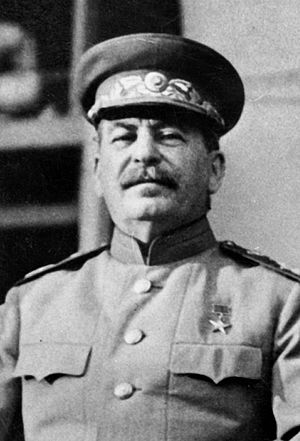
In 2011, journalist Annie Jacobsen wrote Area 51: An Uncensored History of America's Top Secret Military Base. She claimed that Joseph Stalin recruited Josef Mengele, a German doctor, to create "grotesque, child-size aviators." These were supposedly flown to America to cause panic, like Orson Welles' "War of the Worlds" radio show.
Scientists criticized the book for many errors. Historian Richard Rhodes called it "error-ridden." He said Jacobsen seemed "extraordinarily gullible or journalistically incompetent."
Continued Debunking (2017–2020)
In 2017, a UK newspaper reported on slides that some claimed showed a dead alien. These slides were shown at an event in Mexico. But days later, it was revealed the slides were of a mummified Native American child. This child had been on display in a museum for decades.
In 2020, an Air Force historian shared a declassified report. It described a 1951 incident where two Roswell personnel wore poorly fitting radioactive suits. They were retrieving a weather balloon after an atomic test. They met a woman in the desert who fainted when she saw them. To someone not used to the gear, they might have looked like aliens.
Evidence: What Do We Know?
Despite no strong evidence for an alien spaceship, many believers still think one crashed near Roswell. They believe the government is hiding the truth. B. D. Gildenberg called the Roswell incident "the world's most famous... UFO claim."
One researcher, Karl T. Pflock, said Roswell is an example of "quantity over quality." He meant that supporters just gather anything that seems to help their case. They ignore contradictions or absurdities. Kal Korff said some people promote the alien idea for money. He felt many researchers were not doing good work.
Korff stated: "The Roswell UFO myth has been very good business for UFO groups, publishers, for Hollywood, the town of Roswell, the media, and UFOlogy..."
B. D. Gildenberg noted there were many different stories about alien recovery sites. These stories often didn't match the original 1947 report. Some new accounts might have been confused memories of military plane crashes. Others might have been about finding test dummies, as the Air Force suggested.
Charles Ziegler said the Roswell story is like a traditional folk tale. He found six different versions of the story. He said a core story was created from witness accounts. Then, it was changed by those who shared it. New "witnesses" were sought to expand the story. Those who didn't fit the main belief were ignored. This process repeated over time.
Problems with Witness Accounts
Many people were interviewed, but only a few claimed to have seen debris or aliens. Most witnesses were just repeating what others said. Pflock noted that out of over 300 people interviewed for the 1991 book, only 41 were "genuine first- or second-hand witnesses." Only 23 likely saw physical evidence. Of those, only seven said anything that suggested the debris was from another world.
Jesse Marcel first said the material he held in photos was the real debris. But skeptics pointed out that this material was clearly from a balloon. Marcel then changed his story. Skeptics like Robert Todd said Marcel often exaggerated things. For example, Marcel falsely claimed to be a pilot and to have shot down enemy planes. Skeptics believe his changing Roswell story was another example of this.
Problems with Alien Body Witnesses
Only four people claimed to have seen alien bodies firsthand. All these reports came at least 31 years after the event. Critics found problems with these stories. Some were second-hand. Some witnesses made false claims or gave conflicting accounts. Others were elderly and easily confused.
Grey Aliens and False Memory
In popular stories, "grays" are said to be the aliens whose saucer crashed at Roswell. Some say their bodies were found in the wreckage. Others claim some survived. However, alien bodies were not mentioned in connection to Roswell until 1980.
Before 1980, the idea of Grey aliens became popular after the Betty and Barney Hill incident in the 1960s. Barney Hill described a being with large, wrap-around eyes after a hypnosis session. This was after he saw a similar alien on the TV show The Outer Limits. Experts now believe Hill experienced false memory syndrome. This is when therapy methods like hypnosis can create false memories.
Grey aliens then appeared in many books, movies, and TV shows. They were later added to the Roswell legend.
Presidential Comments on Roswell
In 2012, President Barack Obama joked during a visit to Roswell, "I come in peace." In 2020, he joked that UFOs and Roswell used to be the biggest conspiracy. Now, he said, "that seems so tame."
In 2014, former President Bill Clinton said his administration looked into the incident. He said he had "all the Roswell papers reviewed."
In a 2015 interview, Obama was asked about top-secret information. He replied, "It's a little disappointing. People always ask me about Roswell and the aliens and UFOs, and it turns out the stuff going on that's top secret isn't nearly as exciting as you expect."
In June 2020, then-President Donald Trump was asked about releasing more information. He said, "I won’t talk to you about what I know about it, but it’s very interesting."
Roswell as a Modern Myth
A 1997 poll showed that most people believed aliens had visited Earth. They also believed aliens landed at Roswell, and the US government was keeping it secret. Anthropologists Susan Harding and Kathleen Stewart said the Roswell story became popular because it fit the mood of the 1980s. People were interested in "conspiracy, cover-up and repression."
Skeptics and social anthropologists saw the growing stories of alien crashes and government cover-ups as a myth being created. Skeptics Joe Nickell and James McGaha called this the "Roswellian syndrome." They said a myth develops in five stages: incident, debunking, submergence, mythologizing, and reemergence. They predicted this pattern would happen again with other UFO and conspiracy stories.
In Popular Fiction
The Roswell incident has inspired many movies, TV shows, and books:
- In the 1980 film Hangar 18, an alien ship crashes, and the government covers it up.
- The TV series The X-Files (1993–2002) often featured the Roswell Incident.
- In the Star Trek: Deep Space Nine episode "Little Green Men" (1995), characters from the future cause the Roswell incident.
- The 1996 film Independence Day reveals a Roswell crash and cover-up.
- The 1996–97 series Dark Skies featured a secret group covering up Roswell.
- The comic series Roswell, Little Green Man (1996) was inspired by the story.
- The 1998–2001 TV series Seven Days uses time-travel technology from a Roswell crash.
- The 1999 TV movie Roswell: The Aliens Attack features Roswell survivors trying to destroy Earth.
- The 1999–2002 TV series Roswell and its 2019 remake Roswell, New Mexico are based on books about the incident.
- In the 2001 Futurama episode "Roswell That Ends Well", characters from the future cause the Roswell incident.
- The 2002 miniseries Taken shows what happened after Roswell.
- The 2006 comedy Alien Autopsy is about creating the fake autopsy film.
- The 2006–08 online graphic novel Roswell, Texas references the incident.
- The 2008 film Indiana Jones and the Kingdom of the Crystal Skull involves a quest for an alien body from Roswell.
- The 2011 film Paul tells the story of tourists who rescue a grey alien.
Images for kids
-
Joseph Stalin in 1943.
See also
 In Spanish: Caso Roswell para niños
In Spanish: Caso Roswell para niños
- Aztec, New Mexico UFO hoax
- List of conspiracy theories
- List of reported UFO sightings
- UFO conspiracy theory
- Storm Area 51


